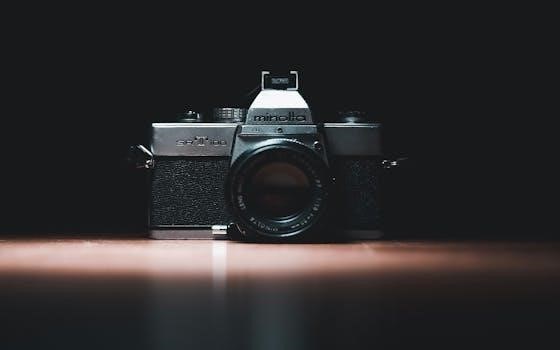
Article Plan⁚ Zoom F3 Field Recorder ⎻ A Comprehensive Guide
This guide offers a complete exploration of the Zoom F3 field recorder.
From initial setup and understanding key features to advanced techniques.
It will empower you to effectively utilize this powerful audio tool.
The Zoom F3 is a compact and robust field recorder designed for capturing high-quality audio in various recording scenarios. Its small size belies its powerful capabilities, making it a favorite among sound recordists, filmmakers, podcasters, and musicians alike.
Unlike traditional recorders that require meticulous gain staging, the F3 boasts a unique 32-bit float recording technology. This innovative feature essentially eliminates the risk of clipping, providing a virtually foolproof method for capturing dynamic audio without distortion. Whether you’re recording a quiet conversation or a loud concert, the F3 ensures that your audio remains clean and usable.
The Zoom F3 is incredibly user-friendly, making it accessible to both seasoned professionals and beginners. Its intuitive interface and straightforward controls allow for quick setup and operation, even in demanding field conditions. Its durability and portability make it an ideal companion for any recording adventure.
This recorder’s design prioritizes ease of use without sacrificing professional-grade audio quality. It’s a versatile tool capable of handling diverse recording needs, from capturing ambient sounds to recording critical dialogue. The F3’s reliability and exceptional audio fidelity make it a valuable asset for anyone serious about sound recording.
Understanding the Key Features
The Zoom F3 field recorder is packed with features designed to simplify and enhance the audio recording process. At its core, the 32-bit float recording is the most significant, eliminating the need to constantly adjust gain levels, preventing clipping, and capturing a wider dynamic range.
It offers two XLR inputs, allowing for simultaneous recording from multiple professional microphones or line-level sources. These inputs are equipped with robust preamps that deliver clean and transparent audio, ensuring that your recordings are of the highest quality. A 3.5mm output is also included for headphone monitoring.
The F3 records directly to SD cards, providing ample storage for extended recording sessions. Its compact and lightweight design makes it easy to carry around, while its rugged construction ensures durability in demanding environments. Power is supplied via AA batteries or a USB power supply, offering flexibility in the field.
The recorder features simple, intuitive controls for recording, playback, and menu navigation. Its bright LCD screen displays essential information, such as recording levels, battery life, and file names. This combination of advanced technology and user-friendly design makes the Zoom F3 a powerful tool for any audio professional.
Setting Up Your Zoom F3 for Optimal Recording
Before embarking on any recording session, proper setup of your Zoom F3 is crucial for achieving optimal audio quality. Begin by inserting fresh batteries or connecting a reliable USB power source to ensure uninterrupted operation. Next, insert a formatted SD card into the designated slot; make sure it meets the speed and capacity requirements outlined in the Zoom F3 manual.
Navigate the menu system to configure the basic settings. Set the date and time for accurate file timestamping. Choose your desired recording format, typically WAV, and select an appropriate sample rate, such as 48kHz or 96kHz, depending on your project’s needs. Familiarize yourself with the input gain settings, understanding that the 32-bit float recording handles gain differently than traditional recorders.
Connect your microphones or audio sources to the XLR inputs, ensuring they are securely fastened. If using phantom power microphones, activate the +48V phantom power on the corresponding input channels. Monitor the input signals through headphones to verify proper connection and signal levels. Adjust headphone volume to a comfortable listening level.
Finally, perform a test recording to confirm that all settings are correct and that the audio is being captured as expected. Review the test recording to identify any potential issues and make necessary adjustments before commencing your primary recording session.
Choosing the Right Recording Format and Sample Rate
Selecting the appropriate recording format and sample rate is paramount for achieving the desired audio quality with your Zoom F3. The Zoom F3 primarily records in WAV format, a lossless audio format that preserves all the sonic details. When choosing a sample rate, consider the project’s requirements and the intended use of the audio. Common sample rates include 44.1kHz, 48kHz, and 96kHz.
44.1kHz is the standard for CD audio and is suitable for general recording purposes. 48kHz is commonly used for video production and offers slightly better fidelity than 44.1kHz. 96kHz provides the highest resolution audio and is ideal for critical listening applications and archival purposes. However, higher sample rates result in larger file sizes, consuming more storage space on your SD card.
The Zoom F3’s 32-bit float recording capability offers significant advantages. It provides an extremely wide dynamic range, preventing clipping and allowing for greater flexibility in post-production. Even if the input levels are set too low, the audio can be easily normalized without introducing noticeable noise. While 32-bit float recording offers considerable benefits, it’s essential to ensure your editing software supports this format.
Consult the Zoom F3 manual for a detailed explanation of the available recording formats and sample rates, along with recommendations for different recording scenarios.
Mastering the Gain Settings on the Zoom F3
While the Zoom F3 boasts 32-bit float recording, which significantly reduces the risk of clipping, understanding gain staging remains crucial for optimal audio quality; The F3 doesn’t have traditional gain knobs; Instead, it relies on the inherent dynamic range of the 32-bit float format to capture audio accurately. However, this doesn’t mean you can disregard input levels entirely.
Monitoring your input levels is still essential. Aim to have your audio peaking somewhere between -20dBFS and -10dBFS. This provides a healthy signal-to-noise ratio without risking clipping. While the 32-bit float format allows for rescuing audio that’s recorded too quietly, starting with a reasonable input level will yield the best results.
Use the F3’s built-in meters to visually monitor your levels. If your audio is consistently peaking too low, consider adjusting the output level of your microphone or other audio source. If it’s consistently too high, even with the source turned down, you might need to use an inline attenuator to reduce the signal strength before it enters the F3.
Although the F3 simplifies gain control, understanding the principles of gain staging will help you achieve cleaner, more professional-sounding recordings. Refer to the Zoom F3 manual for specific guidance on monitoring input levels and troubleshooting any gain-related issues.
Connecting Microphones and Other Audio Sources
The Zoom F3 offers versatile connectivity options for various audio sources. It features two XLR/TRS combo jacks, allowing you to connect microphones, line-level devices, and instruments. When connecting microphones, ensure they are securely plugged into the inputs. For condenser microphones requiring phantom power, activate the +48V phantom power switch located on the side of the unit. Be cautious when using phantom power, as it can damage dynamic microphones if inadvertently activated.
For line-level sources, such as mixers or audio interfaces, use TRS cables for balanced connections, which minimize noise and interference. When connecting instruments like guitars or keyboards, use TS cables. Ensure the input level is appropriate for the connected device to prevent clipping or distortion.
Before recording, test the audio signal from each input to verify proper connectivity and signal strength. Use headphones to monitor the audio and adjust the input levels as needed. If you encounter any issues, consult the Zoom F3 manual for troubleshooting tips and detailed connection diagrams.
Remember to properly secure all cables to prevent accidental disconnections during recording sessions. A stable and reliable connection is crucial for capturing high-quality audio without interruptions. Always double-check your connections before pressing record.
XLR vs. 3.5mm Inputs⁚ Which to Use?

The Zoom F3 primarily utilizes XLR inputs, known for their superior audio quality and robustness compared to 3;5mm inputs. XLR connectors offer a balanced connection, effectively reducing noise and interference, making them ideal for professional recording scenarios. They are the preferred choice for microphones, especially condenser microphones requiring phantom power, as they provide a stable and reliable power supply.
While the Zoom F3 doesn’t feature a dedicated 3.5mm input, understanding the difference is crucial. 3.5mm inputs are typically unbalanced, making them more susceptible to noise and interference. They are commonly found on consumer-grade devices like smartphones and laptops. Although adapters can be used to connect 3.5mm sources to XLR inputs, the resulting audio quality may be compromised due to the inherent limitations of the 3.5mm connection.
For optimal audio quality, always prioritize using XLR inputs with professional-grade microphones and audio sources. Avoid using 3.5mm connections unless absolutely necessary, and be aware of the potential for increased noise and reduced signal quality. Invest in high-quality XLR cables to further enhance the audio performance of your Zoom F3 recordings. Remember to consult the Zoom F3 manual for recommended cable types and best practices for audio connectivity.
Monitoring Audio During Recording
Effective audio monitoring is crucial when using the Zoom F3 to ensure you’re capturing the desired sound accurately. The F3 offers a headphone output for real-time monitoring, allowing you to listen to the incoming audio signal as it’s being recorded. This enables you to identify and address any potential issues, such as unwanted noise, clipping, or incorrect microphone placement, before they ruin your recording.
To monitor effectively, use high-quality headphones that provide a clear and accurate representation of the audio. Adjust the headphone volume to a comfortable level, avoiding excessive loudness that could damage your hearing. Pay close attention to the audio levels and listen for any distortions or unwanted sounds. If you hear any problems, immediately pause the recording and investigate the source of the issue.
The Zoom F3’s manual provides detailed instructions on using the headphone output and adjusting the monitoring settings. Familiarize yourself with these settings to optimize your monitoring experience. Experiment with different headphone types to find the ones that work best for you. Remember, accurate monitoring is essential for capturing high-quality audio with your Zoom F3, leading to professional and polished recordings. Consistent monitoring will improve your overall audio production workflow.
Troubleshooting Common Issues with the Zoom F3
Even with its user-friendly design, the Zoom F3 can occasionally present challenges. Addressing these issues promptly is key to maintaining a smooth recording workflow. One common problem is unexpected battery drain. Ensure you’re using high-quality batteries and that they are fully charged. If the issue persists, check for firmware updates, as these often include power management improvements.
Another frequent concern is audio distortion or clipping. This usually indicates that the input signal is too hot. Review your gain settings and microphone placement to reduce the input level. The F3’s manual provides detailed guidance on setting appropriate gain levels for various recording scenarios. If you encounter error messages on the display, consult the manual for specific troubleshooting steps.
Connectivity problems with microphones or other audio sources can also occur. Double-check all cable connections and ensure that your microphones are properly powered. If you’re using phantom power, verify that it’s enabled for the correct input. By systematically addressing these potential issues and referring to the Zoom F3 manual, you can quickly resolve most problems and get back to recording high-quality audio. Regular maintenance and careful handling will also help prevent future issues.

Tips and Tricks for Advanced Zoom F3 Users
Once you’ve mastered the basics of the Zoom F3, several advanced techniques can elevate your recordings. Experiment with different microphone placements to capture unique sonic perspectives. For example, try using an ORTF stereo configuration for a wider soundstage or an X-Y setup for focused, directional recording. Utilize the F3’s dual recording capabilities to capture a safety track at a lower gain level, providing insurance against unexpected peaks.

Explore the possibilities of using external preamps to further enhance the sound quality. High-end preamps can add warmth and clarity to your recordings. Consider using the F3 as a USB audio interface for recording directly into your computer. This allows you to take advantage of your favorite digital audio workstation (DAW) software for editing and mixing. The F3’s compact size makes it ideal for discreet recording in various environments.
Learn to use the F3 in conjunction with other recording devices for multi-track recording setups. Syncing multiple F3 units can create immersive and complex audio experiences. Regularly back up your recordings to multiple storage locations to prevent data loss. With creative experimentation and a thorough understanding of the F3’s capabilities, you can unlock its full potential and achieve professional-quality results.
Zoom F3 Manual⁚ Navigating the Menu System
Understanding the Zoom F3’s menu system is crucial for unlocking its full potential. The menu is accessed via the dedicated button and navigated using the up/down and select buttons. The “File” menu allows you to manage recordings, including deleting unwanted files and formatting the SD card. The “Input” menu is where you configure the input settings, such as phantom power for condenser microphones and low-cut filters to reduce unwanted rumble. The “Output” menu controls headphone volume and output routing options.

The “System” menu provides access to global settings, including date and time, display brightness, and language preferences. Familiarize yourself with the “Factory Reset” option, which can be helpful for troubleshooting or starting with a clean slate. The “Firmware” section displays the current firmware version and allows you to update the device when new updates are available. Regular firmware updates often include bug fixes and performance improvements.
Pay close attention to the icons and abbreviations used within the menu system, as they provide quick visual cues to the various settings. Experiment with different menu options to understand their impact on your recordings. By systematically exploring each menu item, you’ll gain a comprehensive understanding of the F3’s functionality and be able to quickly adjust settings in the field, ensuring optimal recording performance. Consulting the official Zoom F3 manual alongside is highly recommended.
The Zoom F3 stands out as a remarkably compact and capable field recorder, particularly attractive for those prioritizing portability and ease of use. Its 32-bit float recording technology offers significant advantages, eliminating the need to constantly adjust gain levels and providing peace of mind in unpredictable recording environments. If you frequently record in dynamic situations, such as interviews or live performances, the F3’s forgiving nature can be a lifesaver.
However, the F3’s minimalist design might not appeal to users who require extensive on-board controls or a wide range of input/output options. While its preamps are clean and quiet, they might not match the sonic character of higher-end recorders. Consider your specific needs and workflow. If you value simplicity, reliability, and exceptional dynamic range, the F3 is an excellent choice. If you require advanced features, multiple inputs, or specific sonic qualities, exploring alternative recorders may be worthwhile.
Ultimately, the decision hinges on your priorities and budget. The Zoom F3 offers a compelling blend of performance and affordability, making it a strong contender for anyone seeking a hassle-free field recording experience. Evaluate your recording scenarios, weigh the pros and cons, and determine if the F3’s strengths align with your requirements. Its robust feature set makes it a valuable tool for various recording applications.